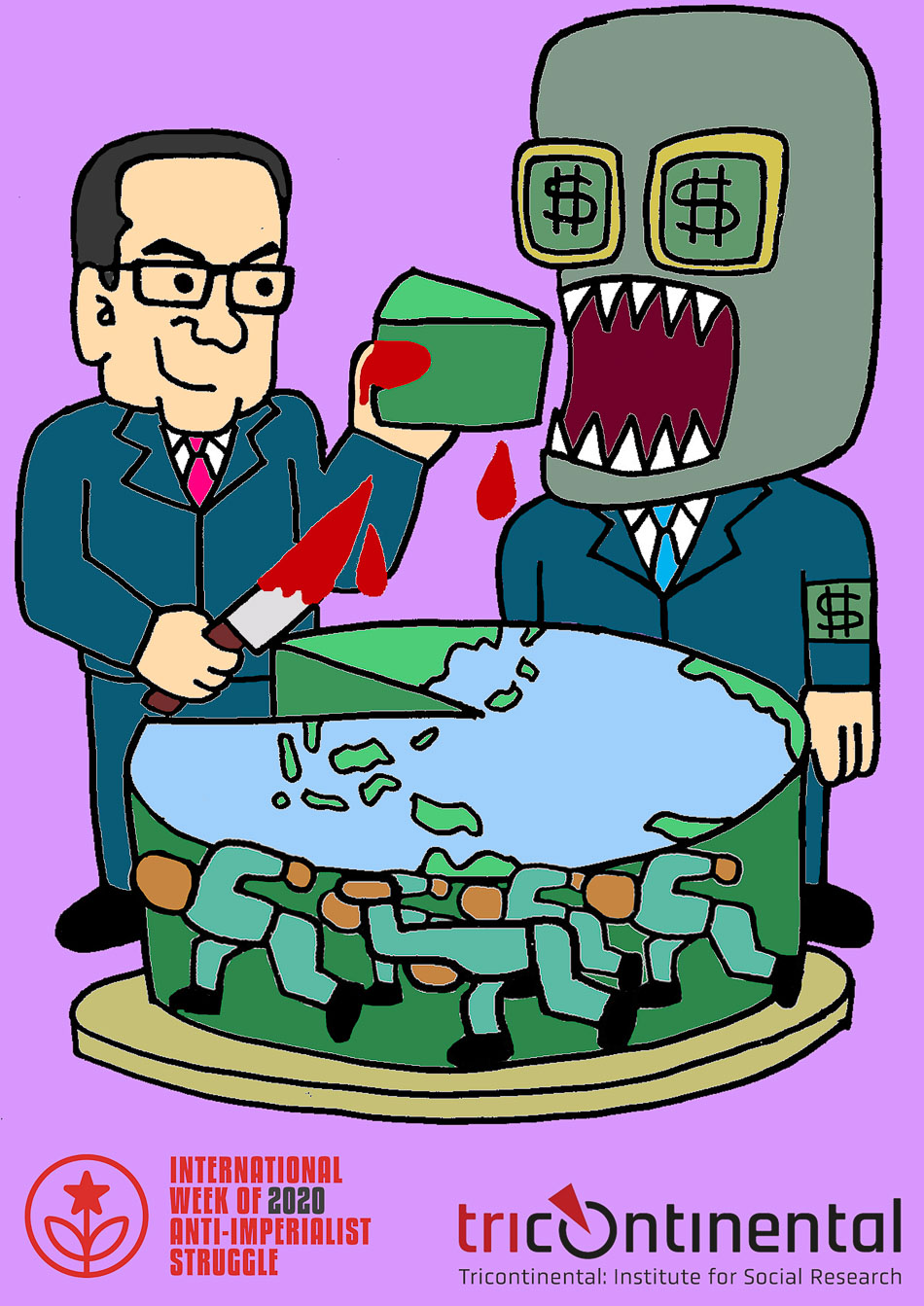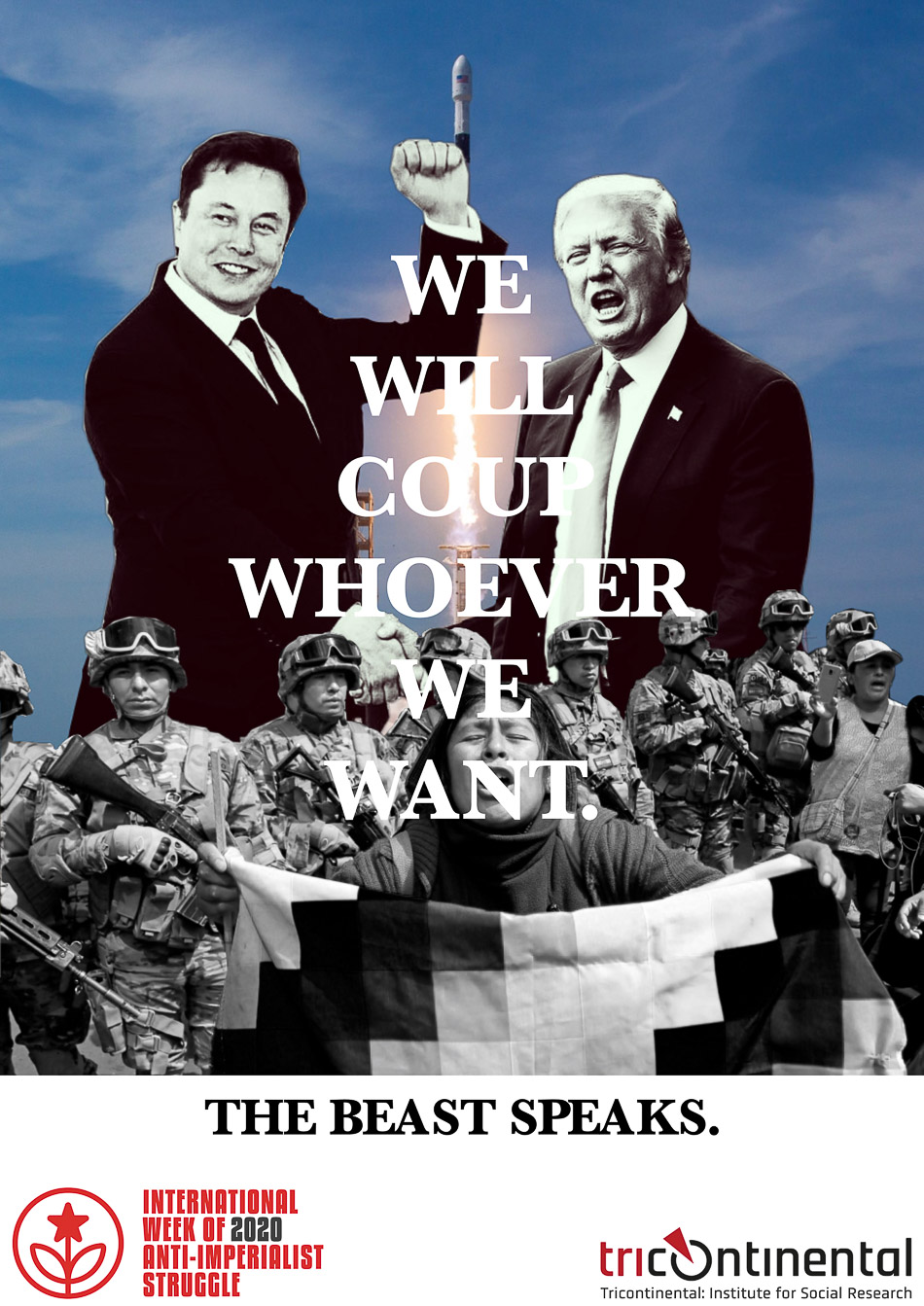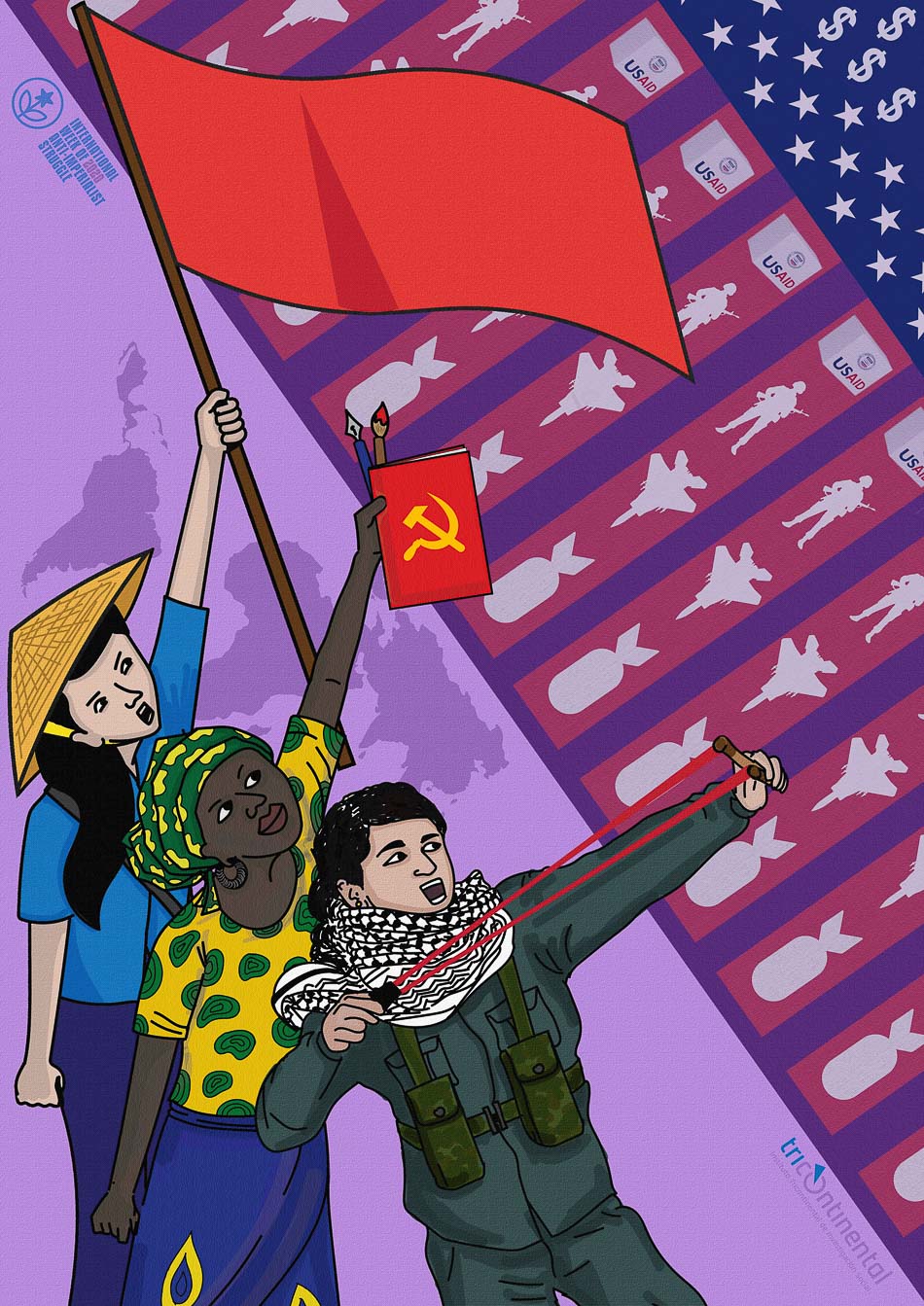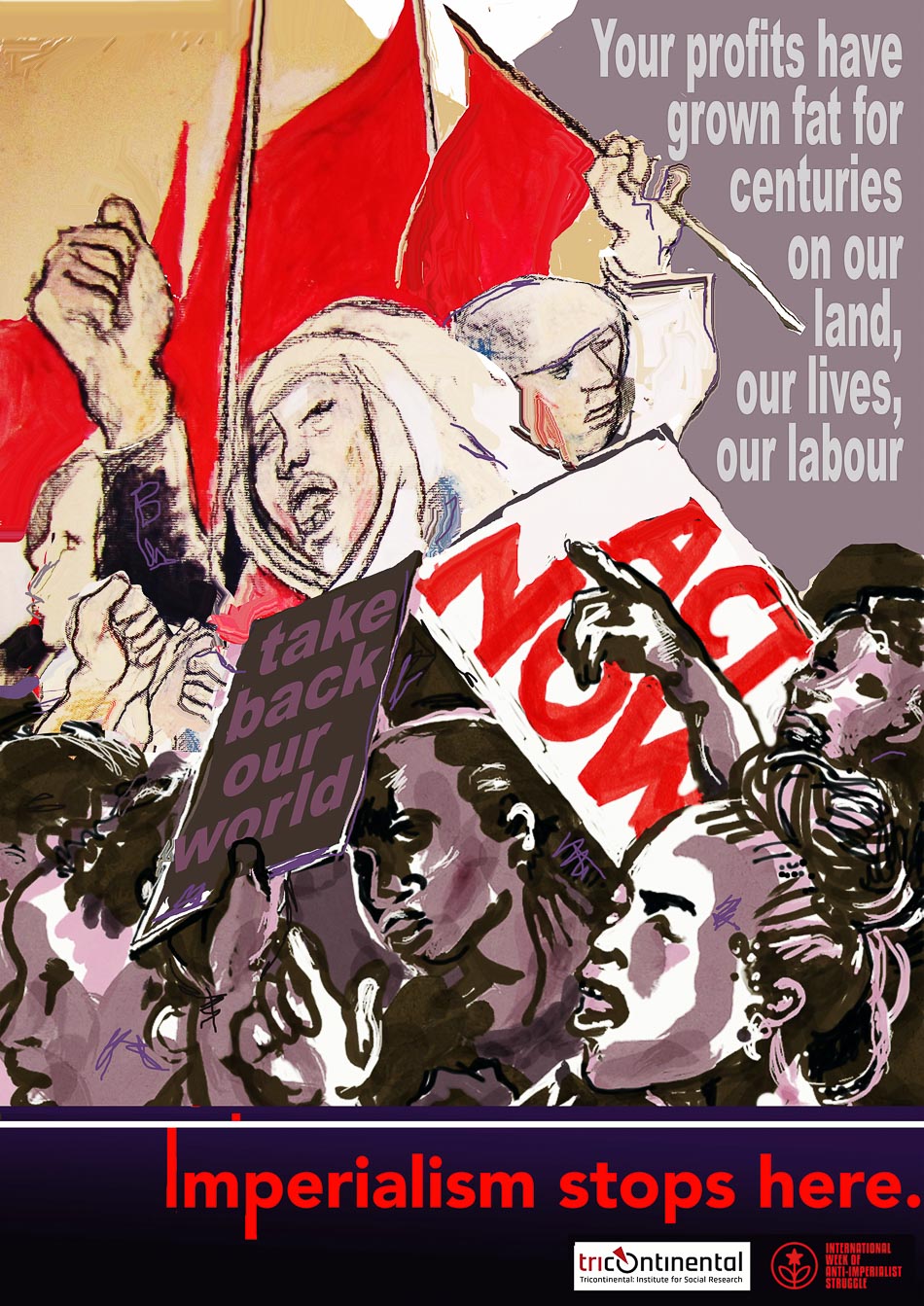‘Our enemy is imperialism, not abstract art’: Collective exhibition review
Share
‘Our enemy is imperialism, not abstract art’, said Cuban leader Fidel Castro. Imperialism is the third in a series of four Anti-Imperialist Poster Exhibitions launched in the context of the week of actions being held 5-10 October 2020. It gathers work from sixty-three artists and militants from twenty-six countries who paint an international portrait of anti-imperialist struggles: the struggles against neo-fascism and military aggressions and for national sovereignty and the protection of the people and the land.
As we come together from across the world to stand up to all manifestations of imperialism, let us be inspired by these bold posters, which depict the face of our enemy and the will of the people to resist. These posters are meant to be shared on social media, printed and pasted on the streets, and used in workshops and discussions; they are both tools and trenches to build our struggle against imperialism. You can download them here.
Land and Maps

Imperialism seeks to control the planet and all of its resources — and, increasingly, outer space as well. It seeks to consolidate this control into fewer and fewer hands; it carves up the globe; it throttles the destinies of entire nations; and it auctions off the land and the resources beneath its surface. Maps have often been deployed in the service of empires’ ambitions — territories demarcated, people divided, whole continents distorted in order to bolster an imperialist vision: rich nations on top, the Global North; the exploited nations, the Global South, below. It is no coincidence, then, that in this exhibition we find the map as a territory of visual contestation.
In Suhail Al-Ali’s (Palestine/Lebanon) poster, the Third World is literally subterranean. In Daniel David Duque Gil’s (Venezuela) What are you waiting for?, imperialism is a many-armed monstrous being, extending its tentacles all over the land, the sea, and space. Many posters depict the structural bondage through which the labour of many produces the wealth for the few. In Martin Pastor’s (Ecuador) The Shredder, an entire continent is passed through a paper shredder to produce dollars; in Choo Chon Kai’s (Malaysia) Sharing economy?, the globe is a piece of cake, cut up for the consumption of the rich. The recurring expressions of the agony of the oppressed is what gives these posters their emotional charge.
The Battle Over Culture

Imperialism exerts its influence over the economies of the usurped states; land opens up to imperialist markets seeking to create an economic outlet for their goods while securing a supply of raw materials. These practices are a blow to all moral values and the right of oppressed people to self-determination. These actions represent one of the highest degrees of imperialist influence; they mandate economic dependency for the weakened states. Essential to this process is the weaponising of culture in order to control the masses — to manufacture consent — both through brute force and soft power, be it through the media, films, fashion, or cultural foundations.
Imperialist regimes strip generations of people of their identity by interfering in the thoughts, beliefs, and traditions that contradict imperialist interests. They plant new concepts into the minds of oppressed peoples to attempt to control their autonomy. They rupture the social and cultural fabric of the Third World, which is then subjected to the tutelage and patronage of the imperialist regimes. We see this in Un Mundo Feliz’s (Spain) Police, where an amalgamation of corporate logos become a form of social control. Racist imperialist tropes imply that the people of Third World are still in their infancy and have not reached adulthood. In this line of thought, they therefore have no right to self-determination.
All of these attempts to destroy the identities and cultures of the people are intended to open markets for international capital, spread consumer culture, and provide a cheap workforce and cheap raw materials. We see this in Whitney Richards-Calathes’s (Jamaica) Different Ships, Same Destruction, where the work of imperialism is carried out by the arms — or ‘ships’ — of military and cultural domination. In the face of tyranny, however, there is always people’s resistance, as expressed in Kimberly Villafuerte Barzola’s (USA) Kawsachun Pachamama, in which the arms of a woman are chasing away the preying birds of imperialism and opening the path for a new dawn.
Eagles and Doves

Among the dozens of posters exhibited in Imperialism, we see a battle over symbols waged through the images of eagles and doves. We see imperialism symbolised by an eagle, but this is not just any eagle – it is white-headed eagle, the bald eagle, as seen in the artwork of Francisco Daniel A. Moreira (Brazil), Wake Up Latin America, It’s Time to Get Up. Along with the flag of the United States, the eagle represents the force of imperialism and how it is built through environmental destruction, multinational capital, and a military industrial complex that is fed by death, war, and destruction. The eagle, the symbol of imperialism, is represented in the posters of Pedro Rangel (Brazil), Alex Aldrich Barrett (USA), Omar Fernández Soto (Mexico), and Jorge Luis Rodriguez Aguilar (Cuba).
On the other side of this epic struggle is the dove – a symbol of peace, which has often been co-opted by that same enemy that brings war, selling a peace that is not the kind that the oppressed peoples of the world need. The ‘peace’ offered in Alex Aldrich Barrett’s (USA) Pax Americana, where US military, intelligence, and finance capital are disguising themselves as a white dove contrasts with the peace that emerges from the people’s struggles, represented in Meshaal Meshaal’s (Palestine) Imperialism is the enemy of the people.
Together, the work shows us that imperialism has many faces and many roles in different parts of the world. In our dedicated fight against imperialism, we must find our many responses, with our many tools — and art is an essential one of them. This exhibition provides a glimpse of this collective, many-faceted, and creative response. Through these images, we are raising our voices together.
The Rise of the Right Wing

In response to criticisms of the US-backed coup against Evo Morales in Bolivia, Tesla’s industrial tycoon Elon Musk declared, ‘We will coup whoever we want! Deal with it.’ This is the tenor of the international right-wing offensive today, which shows contempt to people’s democracy and threatens us by wielding violence in our faces, as depicted by Evan Branan’s (USA) The Beast Speaks.
Led by the United States, an international right wing has arisen and reached a new stage in consolidating its imperialist offensive. Whilst it harkens back to the tragedy that fascism unleashed from Europe during the 1930s, in the words of Karl Marx, this historic moment is repeating itself, ‘first time as tragedy, the second time as farce’. As seen in Adeeb Hamdan’s (Palestine) Imperialism is the Highest Level in the Game of Brutality and Monah Abdsalam Alsaadi’s (Palestine) Oil is the Imperialist Winning Card, big energy companies, tech monopolies, and retail giants now have gruesome puppets and jokers fronting their thuggery and maintaining their thievery.
Though the ultimate caricature of rabid big business interests, Donald Trump does not stand alone. In the deadly card deck of the international right wing, Trump has his counterparts in the likes of Brazil’s Jair Bolsonaro and the Philippine’s Rodrigo Duterte, as Anke Gladnick displays in Fascism in the US props up Fascism in the Philippines. For these gun-toting strong men, violence is often used as an antidote to social problems when the war over culture is not enough to manufacture consent.
The new right wing has ensnared popular discontent and opportunistically jumped in to criticise the economic crisis. But, instead of locating the source of injustice and inequality in the continued domination by finance capital over the working masses, the right wing conjures false enemies. They blame migrants, refugees, the urban and rural poor, women, queer people, and religious minorities. Unless we organise to fight the hatred that they spread in word and deed, they will retain the economic prosperity of the few through all means of ridicule and repression.
Bombs

For decades, the forces of imperialism have used bombs to destroy the lives and livelihoods of the people who have stood in their way. US imperialism has left an indelible mark on the countries it has bombed, from the atomic bombs detonated in Japan to the tons of napalm dropped in Vietnam and the present-day drone strikes in the Middle East. It is no wonder that several artists who have submitted artwork for the Anti-Imperialist Poster Exhibition III have used the imagery of bombs to depict the terror and devastation caused by imperialism.
In Pedro Rangel’s (Brazil) Manifest Destiny, US imperialism is depicted through the image of the bald eagle (the national bird of the United States), superimposed on a falling bomb. This is underscored by the image of lightning in the background symbolising the instant destruction caused by these bombs. The imagery of a bird and a bomb is also used in Meshaal Meshaal’s (Palestine) Imperialism is the Enemy of the People, but with a different significance. In this poster, a militant fighter rides on the back of a dove, which lifts him from the bomb’s reach as they fly towards victory. The poster invokes a sense of hope that, even in the face of devastation and destruction, the people will resist and rise up against imperialism. In Rebel Politik’s (India) Unity of the Oppressed Against Imperialism, bombs, along with soldiers, warplanes, and USAID, are depicted in the thirteen stripes of the US flag, representing the weapons and tools of imperialism. Yet these are overshadowed by the fierce resistance of women representing countries that have faced the brunt of imperialist forces throughout history.
The Handmade

What tool is more direct than the hands? They connect our struggle and our feelings with outlines, shadows, and shapes. This third series of the Anti-Imperialist Poster Exhibition is full of brave lines that describe how the artists and militants experience imperialism in their diverse lands. A multitude of hands leave prints of their people with pencils, acrylics, and watercolours, but with a very different objective than that of ‘high painting.’ This call was not for oil paints to be sold and hung in the houses of the bourgeoisie, as unique objects or commercialised possessions. The artwork in this exhibition is destined to be shared with the people, to fill the streets and the networks of the art that comes out of the hearts and souls of the working class.
In the poster of Ian Gamble (USA), we see imperialism converted into a monster with a thousand hands that use money to corrupt, the cross to pacify, and the rifle to destroy. We also see this connection between the hand and the heart mediated through digital art, which transforms brushwork into the computer language of ones and zeros. The poster of Francisco Daniel A. Moreira (Brazil) also illustrates the force of our ancestors with an image of an indigenous man aiming with the bow and arrow at the eagle of the empire. Likewise, in Fabiola Sánchez Quiroz’s (Mexico) La vida contra el Imperialismo, the peasant’s outstretched hand defends life from the bombs of terror masked as ‘liberty’.
We see how the artist’s hand can multiply into a thousand hands through the creation images. Some hands point at empire, others raise the red flag, and others clench to become fists. Judy Seidman’s (South Africa) Imperialism Stops Here teaches us about the beauty of feeling strong in the collective struggle. The illustrator mixes tools and techniques, creating a river of lines that create faces full of dignity and anger that call on their brothers and sisters to act in response to the imperialist pillaging and exploitation.
But in all of these hands full of ideas, there are also outlines of tenderness and hope, capable of touching people’s hearts and minds – in swaths of purple and red – with the horizon of a socialist future. Neither our hands nor our minds will be territories of conquest.
‘I prefer an old art that participates actively
in the creation of a new human being,
than a new art that does not change
the situation of the old human being.’
–Ricardo Carpani
This text was prepared collectively by the curation team of the Anti-Imperialist Poster Exhibition:
Luciana Balbuena, Tricontinental: Institute for Social Research (Argentina)
Gabriela Barraza, Escuela José Carlos Mariátegui (Argentina)
Ibnou Ali Abdelouahad, Democratic Way (Morocco)
Tings Chak, Tricontinental: Institute for Social Research (China)
David Chung, The People’s Forum (USA)
Sudhanva Deshpande, LeftWord Books (India)
Ingrid Neves, Tricontinental: Institute for Social Research (Brazil)
Mikaela Nhondo Erskog, Socialist Revolutionary Workers Party (South Africa)
Nora García Nieves, Partido Comunista de España (Spain)
Zoe PC, International People’s Assembly and People’s Dispatch (USA)
Ambedkar Pindiga, Tricontinental: Institute for Social Research (India)